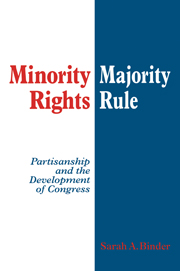Book contents
- Frontmatter
- Contents
- List of tables and figures
- Preface
- 1 The partisan basis of procedural choice
- 2 The evolving concepts of House and Senate minority rights
- 3 Procedural choice in the early Congress: The case of the “previous question”
- 4 Allocating minority rights in the House, 1789–1990
- 5 Institutionalizing party in the nineteenth-century House
- 6 Stacking the partisan deck in the twentieth-century House
- 7 Inherited rules and procedural choice in the Senate
- 8 Assessing the partisan theory
- Appendix 1 Summary of changes in minority rights
- Appendix 2 Measuring congressional workload
- Appendix 3 Measuring party behavior
- Bibliography
- Index
3 - Procedural choice in the early Congress: The case of the “previous question”
Published online by Cambridge University Press: 10 December 2009
- Frontmatter
- Contents
- List of tables and figures
- Preface
- 1 The partisan basis of procedural choice
- 2 The evolving concepts of House and Senate minority rights
- 3 Procedural choice in the early Congress: The case of the “previous question”
- 4 Allocating minority rights in the House, 1789–1990
- 5 Institutionalizing party in the nineteenth-century House
- 6 Stacking the partisan deck in the twentieth-century House
- 7 Inherited rules and procedural choice in the Senate
- 8 Assessing the partisan theory
- Appendix 1 Summary of changes in minority rights
- Appendix 2 Measuring congressional workload
- Appendix 3 Measuring party behavior
- Bibliography
- Index
Summary
In a letter to constituents printed in the Norfolk Gazette and Public Ledger on June 8, 1810, John Stanly (Federalist-North Carolina) made special note of a failed attempt to alter the rules of the House of Representatives to empower the majority party:
If the arguments of the minority did not correspond with the feelings or the interest of the majority, and the majority therefore wished to smother debate, they might under this proposed rule without any regard to the desires of those members who wished to speak, call the “Previous Question”, put an end to all debate … and obtain a decision on the measure proposed, instantly, without amendment or further debate. … This attempt to smite the minority with a political lock-jaw, was not carried into effect… the lips of the minority escaped the Padlock for the Session.
Although the majority failed to adopt a rule to cut off debate at the opening of the 11th Congress, a previous question motion empowering the majority to control debate was enacted into the rules of the House at the start of the 12th Congress in 1811. That rule change was the first significant and successful effort by a House majority to alter formal chamber rules to suppress the minority's right to be heard on the chamber floor.
When the House adopted the previous question rule in 1811, it followed the Senate's rejection of such a rule just a few years earlier in 1806.
- Type
- Chapter
- Information
- Minority Rights, Majority RulePartisanship and the Development of Congress, pp. 43 - 67Publisher: Cambridge University PressPrint publication year: 1997



